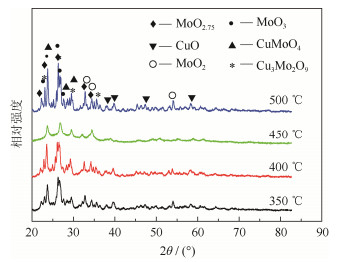| [1] |
Wang D, Wang Y J, Deng W Z, et al. Microstructure and mechanical properties of Mo–ZrC–Cu composites synthesized by reactive melt infiltration of Zr–Cu melt into porous Mo2C preforms at 1300 ℃. Mater Chem Phys, 2018, 212: 51 doi: 10.1016/j.matchemphys.2018.01.033
|
| [2] |
Sun J. Production and Sintering Property of Superfine Mo–40Cu Composite Powder [Dissertation]. Xiangtan: Hunan University of Science and Technology, 2016孙靖. 纳米Mo–40Cu复合粉末的制备及其烧结性能研究[学位论文]. 湘潭: 湖南科技大学, 2016
|
| [3] |
Wang D Z, Zhang Y Q, Duan B H. Preparation of Mo–Cu composite by rapid microwave infiltration. Nonferrous Met Sci Eng, 2018, 9(3): 11 https://www.cnki.com.cn/Article/CJFDTOTAL-JXYS201803003.htm王德志, 张宇晴, 段柏华. 微波快速熔渗制备钼铜复合材料. 有色金属科学与工程, 2018, 9(3): 11 https://www.cnki.com.cn/Article/CJFDTOTAL-JXYS201803003.htm
|
| [4] |
Benavides P A, Benjamín S, Palma R H. Liquid phase sintering of mechanically alloyed Mo–Cu powders. Mater Sci Eng A, 2017, 701: 237 doi: 10.1016/j.msea.2017.06.090
|
| [5] |
Ji X P, Cao W C, Bu C Y, et al. A new route for preparing Mo–10wt%Cu composite compacts. Int J Refract Met Hard Mater, 2019, 81: 196 doi: 10.1016/j.ijrmhm.2019.03.008
|
| [6] |
Wang D Z, Yin B Z, Sun A K, et al. Fabrication of Mo–Cu composite powders by heterogeneous precipitation and the sintering properties of the composite compacts. J Alloys Compd, 2016, 674: 347 doi: 10.1016/j.jallcom.2016.03.027
|
| [7] |
Li B Q, Jin H C, Ding F, et al. Fabrication of homogeneous Mo–Cu composites using spherical molybdenum powders prepared by thermal plasma spheroidization process. Int J Refract Met Hard Mat, 2018, 73: 13 doi: 10.1016/j.ijrmhm.2018.01.022
|
| [8] |
Yao J T, Li C J, Li Y, et al. Relationships between the properties and microstructure of Mo–Cu composites prepared by infiltrating copper into flame-sprayed porous Mo skeleton. Mater Des, 2015, 88: 774 doi: 10.1016/j.matdes.2015.09.062
|
| [9] |
Wang D Z, Li R, Duan B H. Effects of pressure on preparation of Mo–20Cu alloy by hot-press sintering. Rare Met Mater Eng, 2017, 46(7): 1998 https://www.cnki.com.cn/Article/CJFDTOTAL-COSE201707043.htm王德志, 李然, 段柏华. 压力对热压烧结制备Mo–20Cu复合材料的影响. 稀有金属材料与工程, 2017, 46(7): 1998 https://www.cnki.com.cn/Article/CJFDTOTAL-COSE201707043.htm
|
| [10] |
Liu Z W, Li P, Wan Q, et al. Low-temperature combustion synthesis of hexagonal WO3·0.33H2O@C as anode material for lithium ion batteries. J Alloys Compds, 2017, 701: 215 doi: 10.1016/j.jallcom.2017.01.089
|
| [11] |
Zhao Y Y, Jiang N, Zhang X, et al. One-step salt-assisted solution combustion synthesis of Ni-based composites for use as supercapacitor electrodes. J Alloys Compds, 2018, 765: 396 doi: 10.1016/j.jallcom.2018.06.166
|
| [12] |
Johnson J L. Activated liquid phase sintering of W–Cu and Mo–Cu. Int J Refract Met Hard Mater, 2015, 53: 80 doi: 10.1016/j.ijrmhm.2015.04.030
|
| [13] |
Souli I, Terziyska V L, Zechner J, et al. Microstructure and physical properties of sputter-deposited Cu–Mo thin films. Thin Solid Films, 2018, 653: 301 doi: 10.1016/j.tsf.2018.03.039
|
| [14] |
Li P, Liu Z W, Cui L Q, et al. Tungsten carbide synthesized by low-temperature combustion as gas diffusion electrode catalyst. Int J Hydrogen Energy, 2014, 39: 10911 doi: 10.1016/j.ijhydene.2014.04.173
|
| [15] |
Sun J, Guo S B. Fabrication and property of ultrafine Mo–40Cu alloy. Trans Mater Heat Treat, 2016, 37(8): 7 https://www.cnki.com.cn/Article/CJFDTOTAL-JSCL201608002.htm孙靖, 郭世柏. 超细Mo–40Cu合金的制备及其性能. 材料热处理学报, 2016, 37(8): 7 https://www.cnki.com.cn/Article/CJFDTOTAL-JSCL201608002.htm
|
| [16] |
Sun H L, Huang X X, He M J, et al. Preparation and controllability of Cu particles on annealed Mo–Cu alloy films. Mater Lett, 2019, 254: 175 doi: 10.1016/j.matlet.2019.07.044
|
| [17] |
Souli I, Terziyska V L, Zechner J, et al. Microstructure and physical properties of sputter-deposited Cu–Mo thin films. Thin Solid Films, 2018, 653: 301 doi: 10.1016/j.tsf.2018.03.039
|
| [18] |
Cao J, Liu J X, Liu X W, et al. Effect of the distribution state of transition phase on the mechanical properties and failure mechanisms of the W–Mo–Cu alloy by tuning elements content. J Alloys Compd, 2020, 827: 154333 doi: 10.1016/j.jallcom.2020.154333
|




 下载:
下载:










